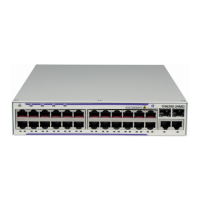Peer Parameters Commands
Page 286 7210 SAS M, T, X, R6, Mxp MPLS Configuration
Guide
Default none
Parameters authentication-key — The authentication key. The key can be any combination of ASCII characters
up to 16 characters in length (unencrypted). If spaces are used in the string, enclose the entire
string in quotation marks (“ ”).
hash-key — The hash key. The key can be any combination of up 33 alphanumeric characters. If
spaces are used in the string, enclose the entire string in quotation marks (“ ”).
This is useful when a user must configure the parameter, but, for security purposes, the actual
unencrypted key value is not provided.
hash — Specifies the key is entered in an encrypted form. If the hash keyword is not used, the key is
assumed to be in a non-encrypted, clear text form. For security, all keys are stored in encrypted
form in the configuration file with the hash parameter specified.
hash2 — Specifies the key is entered in a more complex encrypted form. If the hash2 parameter is
not used, the less encrypted hash form is assumed.
dod-label-distribution
Syntax [no] dod-label-distribution
Context config>router>ldp>peer-parameters>peer
Description This command enables the use of the LDP Downstream-on-Demand (DoD) label distribution
procedures. When this option is enabled, LDP will set the A-bit in the Label Initialization message
when the LDP session to the peer is established. When both peers set the A-bit, they will both use the
DoD label distribution method over the LDP session [rfc5036].
This feature can only be enabled on a link-level LDP session and therefore will apply to prefix labels
only, not service labels. As soon as the link LDP session comes up, the 7210 SAS will send a label
request to its DoD peer for the FEC prefix corresponding to the peer’s LSR-id. The DoD peer LSR-id
is found in the basic Hello discovery messages the peer used to establish the Hello adjacency with the
7210.
Similarly if the 7210 SAS and the directly attached DoD peer entered into extended discovery and
established a targeted LDP session, the 7210 will immediately send a label request for the FEC prefix
corresponding to the peer’s LSR-id found in the extended discovery messages.
However, the 7210 node will not advertise any <FEC, label> bindings, including the FEC of its own
LSR-id, unless the DoD peer requested it using a Label Request Message.
When the DoD peer sends a label request for any FEC prefix, the 7210 will reply with a <FEC, label>
binding for that prefix if the FEC was already activated on the 7210. If not, the 7210 replies with a
notification message containing the status code of “no route.” The 7210 will not attempt in the latter
case to send a label request to the next-hop for the FEC prefix when the LDP session to this next-hop
uses the DoD label distribution mode. Hence the reference to single-hop LDP DoD procedures.
As soon as the link LDP session comes up, the 7210 will send a label request to its DoD peer for the
FEC prefix corresponding to the peer’s LSR-id. The DoD peer LSR-id is found in the basic Hello
discovery messages the peer used to establish the Hello adjacency with the 7210.
The no form of this command disables the DoD label distribution with an LDP neighbor.
Default no dod-label-distribution

